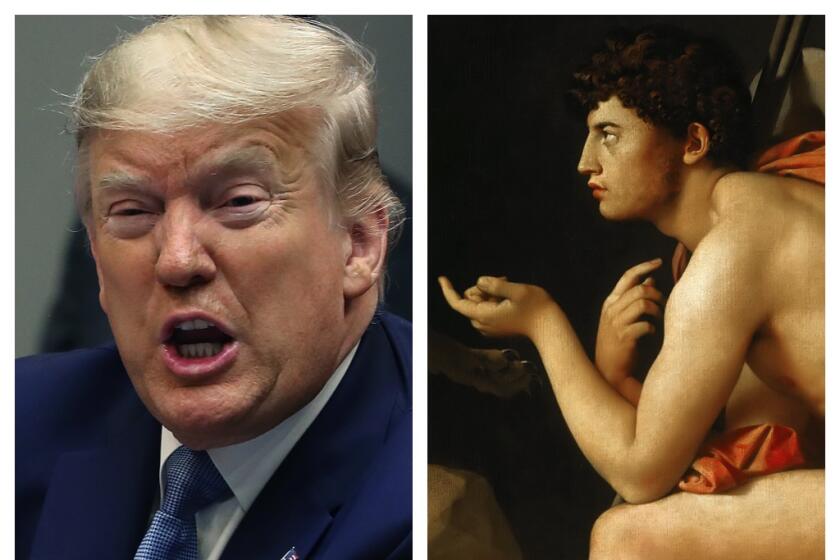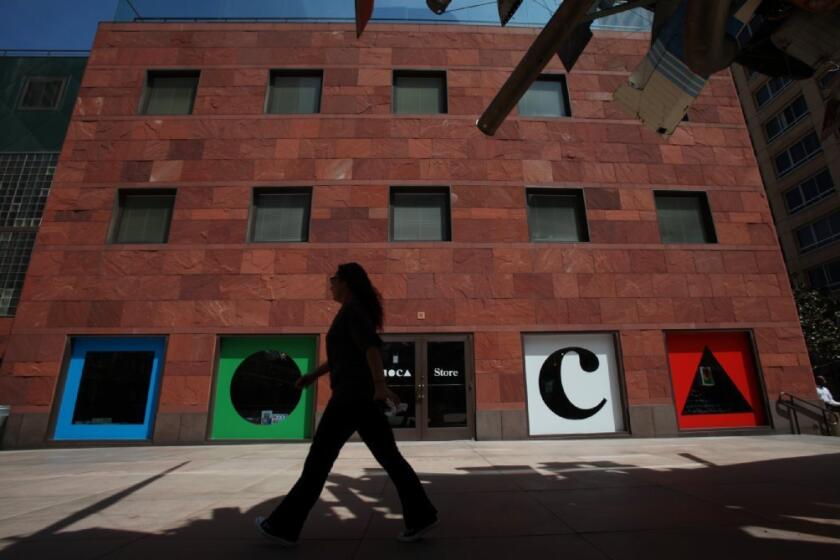Column: Bubonic plague in Europe changed art history. Why coronavirus could do the same
Plagues have a way of focusing the mind. Just ask Millard Meiss.
I admit, that’s a guy I haven’t thought of in ages. Meiss (pronounced Meese) was a celebrated art historian, one of the best in a generation of mid-20th century Americans who followed European innovators in the field. He stood apart because he changed the way we think about Western art of the previous 600 years.
Meiss didn’t do it alone, of course, but he was a leader of the pack. His inspiration was a pandemic — an epic tragedy that many regard as the single greatest natural disaster in the history of Europe.
To analyze art made in the wake of a devastating plague, Meiss brought politics, economics, social relations and their tangled interactions into the very center of the study of art history. The approach was novel.
The title of his first book, a now-classic text published in 1951, is sobering — especially now, as COVID-19 continues its relentless global sweep. “Painting in Florence and Siena After the Black Death: The Arts, Religion and Society in the Mid-Fourteenth Century” takes on Italian art in the aftermath of the bubonic plague.
The calamity upended Europe beginning in 1347. Having already laid waste in Egypt, Syria, Persia, India and parts of China, the pestilence wiped out at least a third of Europe’s population over the next five years. No one was spared — not peasant, aristocrat or cleric. No person was exempt from the ravages to themselves or their families.
Meiss, a historian of medieval art, wondered about the catastrophe’s gruesome impact, considering issues beyond the lives of artists and the nature of art objects that were earlier art historians’ usual focus. Countless artists died during the Black Death, casualties among the millions who succumbed — 25 million, 40 million, no one really knows how many. The artistic loss was huge. But what about the living? How deeply was the entire culture shaken?
When it came to the directions that art would take, especially in Italy, the effect of the Black Death on survivors and their descendants was less often considered. Meiss took a deep look.
Before the pandemic, everyone knew that Giotto di Bondone, widely revered among fellow artists, was the single most inventive, even groundbreaking painter working in Florence in the first part of the century. His paintings were famous all across northern Italy. Giotto had infused the conventional stories of Christian redemption with dramatic tension, pushing aside the formulaic stylization of so much medieval art.
In 1337, Giotto died. The painter, 70, left behind some students, a couple of talented studio assistants and plenty of wannabe admirers. He had teed up a revolution in painting for the second half of the 14th century.
But it never came. Two paintings in the collection of the J. Paul Getty Museum can help explain what happened.
One is a large, lovely, three-panel painting by Bernardo Daddi. It features the Virgin Mary in the center, flanked by Saints Thomas Aquinas to her right and Paul to her left. Its arched Gothic frame, the Virgin’s almond-shaped eyes, the luxurious patterning of her garments and other flattened decorative elements are old-fashioned — as Byzantine and medieval as can be.
But the figures also display something relatively new to Italian art — a lively fullness and spatial volume. Some is created just through savvy juxtapositions of brilliant color.
Those elements don’t speak the language of medieval art — of Constantinople, gateway to and from the Middle East and a hallmark for the standard style of Europe’s Middle Ages. No, those come straight from the fertile mind of Giotto, influential local boy made good — and likely Daddi’s teacher.
Amid the coronavirus, let us consider how the cornerstone text of Western literature is about a ruler discovering himself while confronting an epidemic.
Mary even bursts the two-dimensional picture plane. Her left hand clutches a sacred book held close to her womb, as if to signal the New Testament’s maternal source. By contrast, her graceful right hand reaches out beyond the marble railing just below her waist, a miraculous helping hand offered to any pious spectator gaping in wonder from the other side of the painted stone fence.
Daddi’s painting is dated around 1335, maybe two years before Giotto’s death. Daddi himself died in the fateful year 1347 — commonly presumed to have been felled by the rampaging plague. A direct, supremely gifted link to the post-Giotto future of Florentine painting died with him.
His paintings, though, did not go away. Nor did Giotto’s, nor those made by his admirers. That’s the thing about art: Paintings stick around, still speaking their precise visual language and available for future influence.
Yet the profound, Giotto-inspired transformation underway in traditional medieval art prior to the plague withered. The artistic revolution one might expect in his wake ground to a halt. It skipped a bunch of generations. A renaissance didn’t erupt in Florence for another hundred years.
How to explain the gap? Another Getty painting — a small, 19-inch devotional painting — gives a clue.
Guariento di Arpo was based in Padua, famous site of Giotto’s heartbreaking fresco-cycle in the Arena Chapel. (Pasadena’s Norton Simon Museum also has a large, imposing altarpiece by Guariento.) He knew Giotto’s supreme masterpiece well.
But you wouldn’t know it from the little Getty panel, dating from the late 1340s, when the plague was at its disastrous peak. With death all around, the painting shows a Madonna of Humility — a brand new type of religious image, one so radical that Meiss’ book devotes an entire chapter to it.
In a field of burnished gold, Mary nurses the burbling Christ Child. Rather than enthroned, she sits on the ground like a poor peasant. The pose is unprecedented for the Mother of God, except at the Nativity, but one that underscores humility.
Yet, unassuming Mary also wears a magnificent crown; she’s the regal Queen of Heaven now come down to Earth, ready to comfort humanity after death. A golden sunburst made from incised lines radiates outward around her body, emanating from a medallion of the sun affixed to her chest.
Imagine the dazzle the luxurious little painting’s owner privately beheld by candlelight! Mary transforms from humble mom into apocalyptic spectacle, a vision of eternal power at the end of the world. She’s a mystical triple threat — a flash of luminosity at light’s grand finale.
Culture in plague times: The Florentine Codex, an encyclopedia on Mesoamerican indigenous life, was created as Mexico was ravaged by smallpox
If you’re wondering how this densely compacted little extravaganza of supernaturalism advances Giotto’s revolutionary humanism — well, it doesn’t. Almost none of Giotto’s decisive assertion of homely Christian “people power” inscribed across the walls of that church in Padua is present. How and why such a U-turn happened is a key question Meiss’ book set out to answer.
The historian, steeped in ethereal Gothic art of the Middle Ages, knew the second half of the 14th century was tagged as a period of artistic decline — or at least a backtrack to the comfort of established visual norms, as in Guariento’s otherwise inventive mystical panel. He wanted to know how and why it happened.
Yes, a pandemic had transpired. Brilliant talents like Bernardo Daddi died, putting a severe crimp in things. But Meiss reasoned that the plague also changed the cultural mind-set of the larger society that survived.
The unfolding social, moral and cultural crisis could not be fully understood just by analyzing artistic style or scrutinizing a painting’s symbols. Those tools were necessary, but not enough. To a degree that hadn’t happened before, his study focused on the larger Sienese and Florentine experience.
Meiss joined the who, what, where and when of art to the how and why of the age in which it was made. Traditional art history merged with social history. As he wrote of the millions who survived the cataclysmic Black Death, “their fear, their sense of guilt and the varieties of their religious response” shaped the next century of Italian art.
The Museum of Contemporary Art in Los Angeles lays off gallery attendants, exhibition installers and educators, among others.
The book’s relative brevity — just 165 pages of densely observed text, including copious footnotes, in my paperback copy — belies the head-turning impact it had when first published in 1951. That Meiss wrote it in the immediate aftermath of World War II is probably instructive.
He had lived through another epic human tragedy, one that saw 70 million die. (Meiss’ teacher, the great German-Jewish scholar Erwin Panofsky, had fled the Nazis.) A century already disfigured by the unspeakable horror of World War I, bereft from the calamitous 1918 influenza epidemic and battered by the grinding global trauma of the Great Depression came to a head — all capped by the nuclear specter of global annihilation.
War and plague have been the two primary engines of mass carnage for millennia. Now COVID-19 is drastically changing our lives. Fear, guilt and spiritual upheaval await.
In our time, few artists have had the luxury of working full time making art. With demands for social distancing and sheltering at home meeting losses of jobs, however, many suddenly find themselves with more studio time than they’ve ever had before. Society will change with this pandemic, and art will too — in ways we can only begin to guess.
More to Read
The biggest entertainment stories
Get our big stories about Hollywood, film, television, music, arts, culture and more right in your inbox as soon as they publish.
You may occasionally receive promotional content from the Los Angeles Times.









